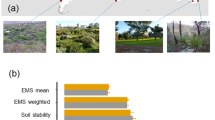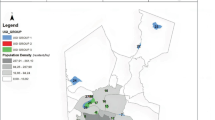Abstract
Green infrastructures (GIs) are environmental designs mainly used to treat urban stormwater runoff pollution. The influences of green infrastructure designs are associated with the bacteria composition and diversity in their soils. This study evaluated the effects of GI design on the composition and function of urban soil bacterial communities in Wuhan, China. GI designs were divided into five different types: engineered (road bioswales, rain gardens, and sunken green spaces) and non-engineered (conventional road greenbelts and urban lawns) designs. The engineered soil combined with the connectivity to urban runoff of the GI design can have strong influences on bacterial community composition and function. Across the five GI design types, we found that the composition of bacterial communities was dominated by Proteobacteria, Acidobacteria, Bacteroidetes and Actinobacteria at the phylum level. The relative abundance of Proteobacteria and Bacteroidetes in the engineered designs was significantly higher than the non-engineered designs and was highest in road bioswales. We detected nine predominant ecological function groups related to the carbon (3 groups) and nitrogen (6 groups) cyclings, with their relative abundance in engineered soils significantly higher than those in non-engineered soils, especially in road bioswales and sunken green spaces. Road bioswales (RBS), with direct connection to urban runoff from street, had the highest denitrification enzyme activity (DEA). DEA of green infrastructures was highly correlated with soil organic carbon, moisture and total nitrogen. Road bioswales appear to function as denitrification hotspots and have higher potential denitrification than other GI designs.





Similar content being viewed by others
Abbreviations
- CRG:
-
Conventional road greenbelts
- DEA:
-
Denitrification enzyme activity
- GI:
-
Green infrastructure
- OUT:
-
Operational taxonomic unit
- PCA:
-
Principal component analysis
- RDA:
-
Redundancy analysis
- RG:
-
Rain gardens
- RBS:
-
Road bioswales
- SG:
-
Sunken green spaces
- SM:
-
Soil moisture
- TN:
-
Total nitrogen
- TOC:
-
Total organic carbon
- UL:
-
Urban lawns
References
Adeniji AO, Okoh OO, Okoh AI. 2017. Petroleum Hydrocarbon Fingerprints of Water and Sediment Samples of Buffalo River Estuary in the Eastern Cape Province, South Africa. J Anal Methods Chem 2017:1–13.
Bettez ND, Groffman PM. 2012. Denitrification Potential in Stormwater Control Structures and Natural Riparian Zones in an Urban Landscape. Environ Sci Technol 46:10909–10917.
Colina M, Ledo H, Gutiérrez E, Villalobos E, Marín J. 1996. Determination of total phosphorus in sediments by means of high-pressure bombs and ion chromatography. J Chromatogr A 739:223–227.
De Mandal S, Chatterjee R, Kumar NS. 2017. Dominant bacterial phyla in caves and their predicted functional roles in C and N cycle. BMC Microbiol 17:90.
De Vargas MC, De Medina HL, Villalobos E, Gutierrez E, Mazurek R. 1995. Determination of total nitrogen in sediments by using high-pressure bombs and ion chromatography. The Analyst 120:761.
Deeb M, Groffman PM, Joyner JL, Lozefski G, Paltseva A, Lin B, Mania K, Cao DL, McLaughlin J, Muth T, Prithiviraj B, Kerwin J, Cheng Z. 2018. Soil and microbial properties of green infrastructure stormwater management systems. Ecol Eng 125:68–75.
Don A, Schumacher J, Freibauer A. 2011. Impact of tropical land-use change on soil organic carbon stocks - a meta-analysis. Glob Change Biol 17:1658–1670.
Feng X, Sun X, Li S, Zhang J, Hu N. 2021. Relationship study among soils physicochemical properties and bacterial communities in urban green space and promotion of its composition and network analysis. Agron J 113:515–526.
Flynn KM, Traver RG. 2013. Green infrastructure life cycle assessment: A bio-infiltration case study. Ecol Eng 55:9–22.
Gill AS, Lee A, McGuire KL. 2017. Phylogenetic and Functional Diversity of Total (DNA) and Expressed (RNA) Bacterial Communities in Urban Green Infrastructure Bioswale Soils. Appl Environ Microbiol 83:15.
Gill AS, Purnell K, Palmer MI, Stein J, McGuire KL. 2020. Microbial Composition and Functional Diversity Differ Across Urban Green Infrastructure Types. Front Microbiol 11:912.
Green TL, Kronenberg J, Andersson E, Elmqvist T, Gómez-Baggethun E. 2016. Insurance Value of Green Infrastructure in and Around Cities. Ecosystems 19(6):1051–1063.
Groffman PM, Altabet MA, Böhlke JK, Butterbach-Bahl K, David MB, Firestone MK, Giblin AE, Kana TM, Nielsen LP, Voytek MA. 2006. Methods for measuring denitrification:diverse approaches to a difficult problem. Ecol Appl 16:2091–2122.
Hogan DM, Walbridge MR. 2007. Urbanization and nutrient retention in freshwater riparian wetlands. Ecol Appl 17:1142–1155.
Hou L, Zheng Y, Liu M, Gong J, Zhang X, Yin G, You L. 2013. Anaerobic ammonium oxidation (anammox) bacterial diversity, abundance, and activity in marsh sediments of the Yangtze Estuary. J Geophys Res Biogeosciences 118:1237–1246.
Huot H. 2017. Characterizing urban soils in New York City: profile properties and bacterial communities. J Soils Sediments:15.
Joyner JL, Kerwin J, Deeb M, Lozefski G, Prithiviraj B, Paltseva A, McLaughlin J, Groffman P, Cheng Z, Muth TR. 2019. Green Infrastructure Design Influences Communities of Urban Soil Bacteria. Front Microbiol 10:982.
Khan MAI, Biswas B, Smith E, Mahmud SA, Hasan NA, Khan MAW, Naidu R, Megharaj M. 2018. Microbial diversity changes with rhizosphere and hydrocarbons in contrasting soils. Ecotoxicol Environ Saf 156:434–442.
Li L, Davis AP. 2014. Urban Stormwater Runoff Nitrogen Composition and Fate in Bioretention Systems. Environ Sci Technol 48:3403–3410.
Louca S, Parfrey LW, Doebeli M. 2016. Decoupling function and taxonomy in the global ocean microbiome. Science:7.
Morel JL, Chenu C, Lorenz K. 2015. Ecosystem services provided by soils of urban, industrial, traffic, mining, and military areas (SUITMAs). J Soils Sediments 15:1659–1666.
Morse NR, McPhillips LE, Shapleigh JP, Walter MT. 2017. The Role of Denitrification in Stormwater Detention Basin Treatment of Nitrogen. Env Sci Technol:8.
Nowak DJ, Walton JT. 2005. Projected Urban Growth (2000 – 2050) and Its Estimated Impact on the US Forest Resource. J For:7.
Oshiki M, Satoh H, Okabe S. 2016. Ecology and physiology of anaerobic ammonium oxidizing bacteria. Environ Microbiol 18:2784–2796.
Palta MM, Ehrenfeld JG, Groffman PM. 2014. “Hotspots” and “Hot Moments” of Denitrification in Urban Brownfield Wetlands. Ecosystems 17(7):1121–1137.
Payne EGI, Fletcher TD, Cook PLM, Deletic A, Hatt BE. 2014. Processes and Drivers of Nitrogen Removal in Stormwater Biofiltration. Crit Rev Environ Sci Technol 44:796–846.
Reese AT, Savage A, Youngsteadt E, McGuire KL, Koling A, Watkins O, Frank SD, Dunn RR. 2016. Urban stress is associated with variation in microbial species composition—but not richness—in Manhattan. ISME J:10.
Tanaka Y, Tamaki H, Matsuzawa H, Nigaya M, Mori K, Kamagata Y. 2012. Microbial Community Analysis in the Roots of Aquatic Plants and Isolation of Novel Microbes Including an Organism of the Candidate Phylum OP10. Microbes Environ 27:149–157.
Trimmer M, Nicholls JC, Deflandre B. 2003. Anaerobic Ammonium Oxidation Measured in Sediments along the Thames Estuary, United Kingdom. Appl Environ Microbiol 69:6447–6454.
Tzoulas K, Korpela K, Venn S, Yli-Pelkonen V, Kaźmierczak A, Niemela J, James P. 2007. Promoting ecosystem and human health in urban areas using Green Infrastructure: A literature review. Landsc Urban Plan 81:167–178.
Valenca R, Le H, Zu Y, Dittrich TM, Tsang DCW, Datta R, Sarkar D, Mohanty SK. 2021. Nitrate removal uncertainty in stormwater control measures: Is the design or climate a culprit? Water Res 190:116781.
Veerkamp CJ, Schipper AM, Hedlund K, Lazarova T, Nordin A, Hanson HI. 2021. A review of studies assessing ecosystem services provided by urban green and blue infrastructure. Ecosyst Serv 52:101367.
Waller LJ, Evanylo GK, Krometis L-AH, Strickland MS, Wynn-Thompson T, Badgley BD. 2018. Engineered and Environmental Controls of Microbial Denitrification in Established Bioretention Cells. Environ Sci Technol 52:5358–5366.
Walsh CJ, Roy AH, Feminella JW, Cottingham PD, Groffman PM, Morgan RP. 2005. The urban stream syndrome: current knowledge and the search for a cure. J North Am Benthol Soc 24:706–723.
Wang X, Yang H, Gu Z, Zhang M, Yang B. 2018a. A century of change in sediment accumulation and trophic status in Lake Fuxian, a deep plateau lake of Southwestern China. J Soils Sediments 18:1133–1146.
Wang H, Cheng M, Dsouza M, Weisenhorn P, Zheng T, Gilbert JA. 2018b. Soil Bacterial Diversity Is Associated with Human Population Density in Urban Greenspaces. Environ Sci Technol 52:5115–5124.
Wu H-L, Cheng W-C, Shen S-L, Lin M-Y, Arulrajah A. 2020. Variation of hydro-environment during past four decades with underground sponge city planning to control flash floods in Wuhan, China: An overview. Undergr Space 5:184–198.
Xia J, Zhang Y, Xiong L, He S, Wang L, Yu Z. 2017. Opportunities and challenges of the Sponge City construction related to urban water issues in China. Sci China Earth Sci 60:652–658.
Xu N, Tan G, Wang H, Gai X. 2016. Effect of biochar additions to soil on nitrogen leaching, microbial biomass and bacterial community structure. Eur J Soil Biol 74:1–8.
Xu M, Xia H, Wu J, Yang G, Zhang X, Peng H, Yu X, Li L, Xiao H, Qi H. 2017. Shifts in the relative abundance of bacteria after wine-lees-derived biochar intervention in multi metal-contaminated paddy soil. Sci Total Environ 599–600:1297–1307.
Yoon S, Cruz-García C, Sanford R, Ritalahti KM, Löffler FE. 2015. Denitrification versus respiratory ammonification: environmental controls of two competing dissimilatory NO3−/NO2− reduction pathways in Shewanella loihica strain PV-4. ISME J 9:1093–1104.
Zhang J, Li S, Sun X, Tong J, Fu Z, Li J. 2019. Sustainability of Urban Soil Management: Analysis of Soil Physicochemical Properties and Bacterial Community Structure under Different Green space Types. Sustainability 11:1395.
Zhou G, Xu X, Qiu X, Zhang J. 2019. Biochar influences the succession of microbial communities and the metabolic functions during rice straw composting with pig manure. Bioresour Technol 272:10–18.
Acknowledgements
We thank Wuhan Wugang Sponge City Construction Project Investment Co. Liyong Cao provided invaluable information on GI design specifications.
Funding
This research was supported by grants from the National Natural Science Foundation of China (Grant Nos. 41977155), and the Key Research and Development Program of Hubei Province (2021BCA128).
Author information
Authors and Affiliations
Corresponding author
Ethics declarations
Conflict of interest
The authors declare that they have no known competing financial interests or personal relationships that could influence the work reported in this paper.
Additional information
Author contributions: LL and SL designed the study. SL, XM and YY conducted soil sampling and processing. LL and SL analyzed the data and wrote the manuscript.
Supplementary Information
Below is the link to the electronic supplementary material.
Rights and permissions
Springer Nature or its licensor holds exclusive rights to this article under a publishing agreement with the author(s) or other rightsholder(s); author self-archiving of the accepted manuscript version of this article is solely governed by the terms of such publishing agreement and applicable law.
About this article
Cite this article
Li, L., Li, S., Ma, X. et al. Effects of Urban Green Infrastructure Designs on Soil Bacterial Community Composition and Function. Ecosystems 26, 815–825 (2023). https://doi.org/10.1007/s10021-022-00797-y
Received:
Accepted:
Published:
Issue Date:
DOI: https://doi.org/10.1007/s10021-022-00797-y




